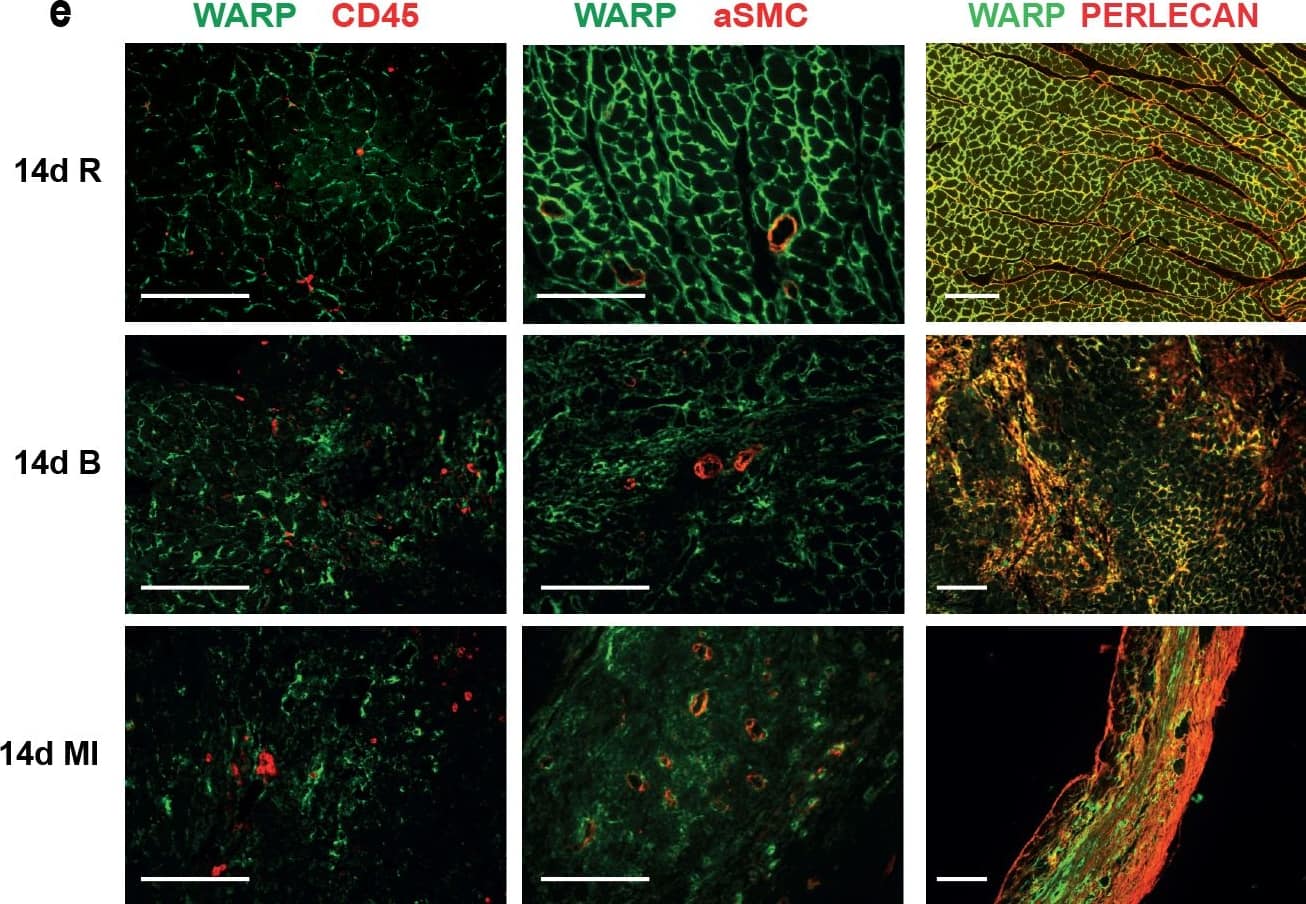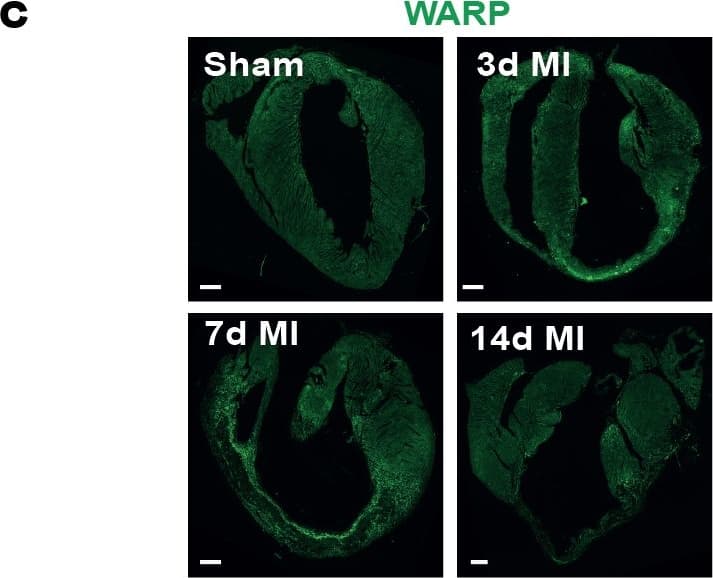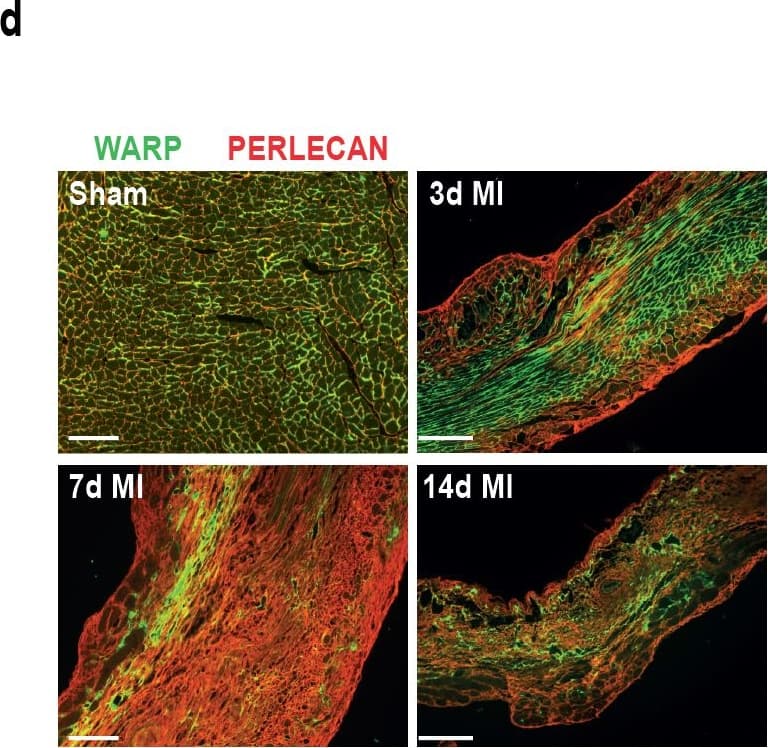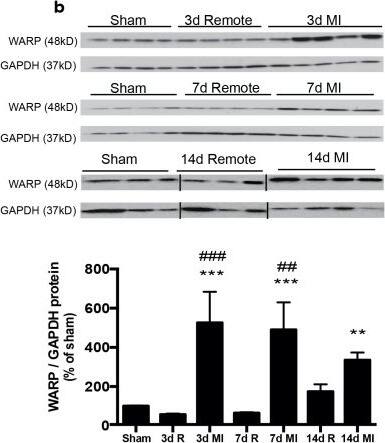Mouse WARP Antibody Summary
Arg19-Pro415
Accession # Q8R2Z5
Applications
Please Note: Optimal dilutions should be determined by each laboratory for each application. General Protocols are available in the Technical Information section on our website.
Scientific Data
 View Larger
View Larger
Detection of Mouse WARP/VWA1 by Immunocytochemistry/Immunofluorescence WARP expression pattern in the heart.(a) WARP mRNA levels were induced 3 and 7 days after MI. WARP mRNA levels peaked at 7 days after MI and then decreased again at 14 days. (b) Western blot analysis and (c) immunohistochemistry also showed an induction of WARP protein levels in the infarcted LV at 3, 7, and 14 days after MI. Because of different sample-loading, the blots of the 14 days MI were cut and pasted in the same order as the blots of the 3 and 7 days MI. Images of the original unadjusted blots are provided in S1 Fig (d and e) Confocal microscopy confirmed the co-localization of WARP with perlecan in the uninfarcted heart, showing a network of WARP and perlecan as a honeycomb-structure surrounding the cardiomyocytes. In the infarcted LV zones, the WARP-perlecan honeycomb-structure is reduced at 3 days after MI and completely absent at 7 and 14 days after MI and the interaction between WARP and perlecan is disrupted. (e) WARP did not localize on CD45 positive leukocytes or in alpha smooth muscle cells lining the vessels in the remote, border and infarcted zone of the heart 14 days after MI. n≥3; *p≤0.05; **p≤0.005; ***p≤0.001 versus sham, ##p≤0.005; ###p≤0.001 versus remote, bars 1000 μm for (c) and 100 μm for (d) and (e). Image collected and cropped by CiteAb from the following publication (https://dx.plos.org/10.1371/journal.pone.0139199), licensed under a CC-BY license. Not internally tested by R&D Systems.
 View Larger
View Larger
Detection of Mouse WARP/VWA1 by Immunocytochemistry/Immunofluorescence WARP expression pattern in the heart.(a) WARP mRNA levels were induced 3 and 7 days after MI. WARP mRNA levels peaked at 7 days after MI and then decreased again at 14 days. (b) Western blot analysis and (c) immunohistochemistry also showed an induction of WARP protein levels in the infarcted LV at 3, 7, and 14 days after MI. Because of different sample-loading, the blots of the 14 days MI were cut and pasted in the same order as the blots of the 3 and 7 days MI. Images of the original unadjusted blots are provided in S1 Fig (d and e) Confocal microscopy confirmed the co-localization of WARP with perlecan in the uninfarcted heart, showing a network of WARP and perlecan as a honeycomb-structure surrounding the cardiomyocytes. In the infarcted LV zones, the WARP-perlecan honeycomb-structure is reduced at 3 days after MI and completely absent at 7 and 14 days after MI and the interaction between WARP and perlecan is disrupted. (e) WARP did not localize on CD45 positive leukocytes or in alpha smooth muscle cells lining the vessels in the remote, border and infarcted zone of the heart 14 days after MI. n≥3; *p≤0.05; **p≤0.005; ***p≤0.001 versus sham, ##p≤0.005; ###p≤0.001 versus remote, bars 1000 μm for (c) and 100 μm for (d) and (e). Image collected and cropped by CiteAb from the following publication (https://dx.plos.org/10.1371/journal.pone.0139199), licensed under a CC-BY license. Not internally tested by R&D Systems.
 View Larger
View Larger
Detection of Mouse WARP/VWA1 by Immunocytochemistry/Immunofluorescence WARP expression pattern in the heart.(a) WARP mRNA levels were induced 3 and 7 days after MI. WARP mRNA levels peaked at 7 days after MI and then decreased again at 14 days. (b) Western blot analysis and (c) immunohistochemistry also showed an induction of WARP protein levels in the infarcted LV at 3, 7, and 14 days after MI. Because of different sample-loading, the blots of the 14 days MI were cut and pasted in the same order as the blots of the 3 and 7 days MI. Images of the original unadjusted blots are provided in S1 Fig (d and e) Confocal microscopy confirmed the co-localization of WARP with perlecan in the uninfarcted heart, showing a network of WARP and perlecan as a honeycomb-structure surrounding the cardiomyocytes. In the infarcted LV zones, the WARP-perlecan honeycomb-structure is reduced at 3 days after MI and completely absent at 7 and 14 days after MI and the interaction between WARP and perlecan is disrupted. (e) WARP did not localize on CD45 positive leukocytes or in alpha smooth muscle cells lining the vessels in the remote, border and infarcted zone of the heart 14 days after MI. n≥3; *p≤0.05; **p≤0.005; ***p≤0.001 versus sham, ##p≤0.005; ###p≤0.001 versus remote, bars 1000 μm for (c) and 100 μm for (d) and (e). Image collected and cropped by CiteAb from the following publication (https://dx.plos.org/10.1371/journal.pone.0139199), licensed under a CC-BY license. Not internally tested by R&D Systems.
 View Larger
View Larger
Detection of Mouse WARP/VWA1 by Western Blot WARP expression pattern in the heart.(a) WARP mRNA levels were induced 3 and 7 days after MI. WARP mRNA levels peaked at 7 days after MI and then decreased again at 14 days. (b) Western blot analysis and (c) immunohistochemistry also showed an induction of WARP protein levels in the infarcted LV at 3, 7, and 14 days after MI. Because of different sample-loading, the blots of the 14 days MI were cut and pasted in the same order as the blots of the 3 and 7 days MI. Images of the original unadjusted blots are provided in S1 Fig (d and e) Confocal microscopy confirmed the co-localization of WARP with perlecan in the uninfarcted heart, showing a network of WARP and perlecan as a honeycomb-structure surrounding the cardiomyocytes. In the infarcted LV zones, the WARP-perlecan honeycomb-structure is reduced at 3 days after MI and completely absent at 7 and 14 days after MI and the interaction between WARP and perlecan is disrupted. (e) WARP did not localize on CD45 positive leukocytes or in alpha smooth muscle cells lining the vessels in the remote, border and infarcted zone of the heart 14 days after MI. n≥3; *p≤0.05; **p≤0.005; ***p≤0.001 versus sham, ##p≤0.005; ###p≤0.001 versus remote, bars 1000 μm for (c) and 100 μm for (d) and (e). Image collected and cropped by CiteAb from the following publication (https://dx.plos.org/10.1371/journal.pone.0139199), licensed under a CC-BY license. Not internally tested by R&D Systems.
Reconstitution Calculator
Preparation and Storage
- 12 months from date of receipt, -20 to -70 °C as supplied.
- 1 month, 2 to 8 °C under sterile conditions after reconstitution.
- 6 months, -20 to -70 °C under sterile conditions after reconstitution.
Background: WARP
WARP (von Willebrand factor A [vWFA] domain-related protein) is a 50 kDa glycoprotein member of the vWFA domain superfamily of extracellular matrix proteins. It is expressed in embryonic articular cartilage, skeletal muscle and basement membranes in the PNS. WARP forms disulfide-linked homodimers and multimers, and complexes with perlecan. Secreted mouse WARP is 397 amino acids (aa) in length. It contains a vWFA domain (aa 34‑209), and two fibronectin type III domains (aa 211‑394) that likely bind to the GAG modification of perlecan. Cys369 and Cys393 contribute to intermolecular bond formation. There is one alternate start site at Met213. Mature mouse WARP (aa 19‑415) is 93% and 78% aa identical to rat and human WARP, respectively.
Product Datasheets
Citations for Mouse WARP Antibody
R&D Systems personnel manually curate a database that contains references using R&D Systems products. The data collected includes not only links to publications in PubMed, but also provides information about sample types, species, and experimental conditions.
2
Citations: Showing 1 - 2
Filter your results:
Filter by:
-
Breeding Strategy Determines Rupture Incidence in Post-Infarct Healing WARPing Cardiovascular Research.
Authors: Deckx S, Carai P, Bateman J, Heymans S, Papageorgiou A
PLoS ONE, 2015-09-25;10(9):e0139199.
Species: Mouse
Sample Types: Tissue Homogenates, Whole Tissue
Applications: IHC, Western Blot -
IkappaB kinase activity drives fetal lung macrophage maturation along a non-M1/M2 paradigm.
Authors: Stouch A, Zaynagetdinov R, Barham W, Stinnett A, Slaughter J, Yull F, Hoffman H, Blackwell T, Prince L
J Immunol, 2014-06-30;193(3):1184-93.
Species: Mouse
Sample Types: Whole Tissue
Applications: IHC
FAQs
No product specific FAQs exist for this product, however you may
View all Antibody FAQsReviews for Mouse WARP Antibody
There are currently no reviews for this product. Be the first to review Mouse WARP Antibody and earn rewards!
Have you used Mouse WARP Antibody?
Submit a review and receive an Amazon gift card.
$25/€18/£15/$25CAN/¥75 Yuan/¥1250 Yen for a review with an image
$10/€7/£6/$10 CAD/¥70 Yuan/¥1110 Yen for a review without an image

